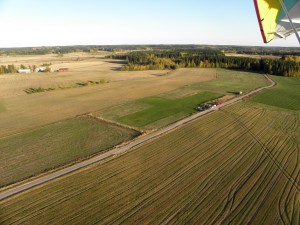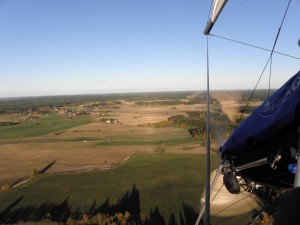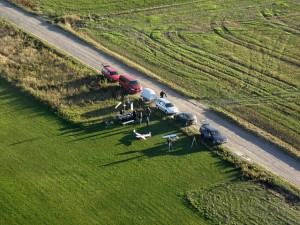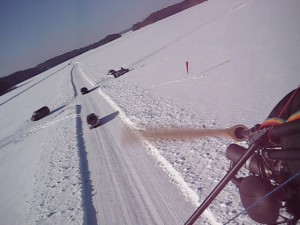 Lennettäessä kaksitahtimoottorilla tulee turvallinen laskupaikka olla aina liitomatkan päässä. Vaikka moottoroiduissa riippuliitimissä käytetty Radne on suhteellisen luotettava, ei omaa turvallisuutta kannata laittaa moottorin varaan.
Lennettäessä kaksitahtimoottorilla tulee turvallinen laskupaikka olla aina liitomatkan päässä. Vaikka moottoroiduissa riippuliitimissä käytetty Radne on suhteellisen luotettava, ei omaa turvallisuutta kannata laittaa moottorin varaan.
Hitaan lentonopeutensa ansiosta moottoroitu liidin ei välttämättä tarvitse lentokenttää lentoonlähtö- tai laskupaikaksi, vaikka usein se onkin helpoin ja turvallisin valinta. Laskeutumiset onnistuvat tarvittaessa myös pelloille, tienpätkille tai muille vastaaville, avoimille paikoille. Lentoonlähdössä liidin tarvitsee enemmän vapaata tilaa ympärillään, 1-2 m/s nousunopeutensa vuoksi. Myötätuuleen
Lentoonlähtö- ja laskupaikan valinnassa on muutamia kriteerejä, jotka tulee ottaa huomioon. Paikan suunta vallitsevaan tuuleen nähden on ensimmäinen valintakriteeri. Kaikki laskeutumiset ja lentoonlähdöt suoritetaan aina vastatuuleen. Myötätuuleen kääntyminen liian matalalla lentoonlähdön jälkeen johtaa ongelmiin. Mikäli paikka ei salli turvallista lentoonlähtöä ja laskeutumista vastatuuleen, tulee valita toinen. Tuulen suunnan voi päätellä esimerkiksi veden liikkeistä, puista, savuista, lipuista ja viireistä, mikä nyt ylipäänsä tuulessa liikkuu. Ja voihan sinne kentälle viedä oman tuulipussin tai viirin. Laskupaikkaa valitessa lentäjän tuoreessa muistissa on vielä varmasti suunta, johon alunperin lentoon lähdettiin, olkoonkin että tuulen suunta voi vähän vaihdella.
(Kuvat ovat Joutsenon lennokkikentältä. Kenttä on peltojen välissä oleva, tasaista ruohoa kasvava pienehkö kenttä, jonne laskeutuminen ja lentoonlähtö oli varsin mukavaa. Ja olenpa joskus tuolta tieltäkin lähtenyt lentoon.. 😉 )

Peltojen halki kulkee usein sähkölinjoja. Niiden ohella pellot voivat olla miinoitettuja sähköpaimenilla ja muilla vastaavilla esteillä. Nämä tulee huomioida hyvissä ajoin ennen laskeutumista tai lentoonlähtöä. Mikäli paikka viettää johonkin suuntaan, ei se ole myöskään hyvä valinta. Alamäkeen laskeutuminen johtaa varmaan rypemiseen.
Laskupaikan pinnalla on suorituksen onnistumisen kannalta myös suuri merkitys. Liidin ja lentäjä hyytyvät pitkään heinikkoon. Vaikka lentäjä jaksaisi siinä juosta, moottoroidun riippuliitimen pyörät tai jalakset tarttuvat heinikkoon kiinni. Epätasainen pinta, kuten kynnöspelto, vaikuttaa aika lailla samalla tavalla. Paitsi että siinä juokseminen on ikävää, ovat nilkan nyrjähdys ja muut vastaavat varsin todennäköisiä. Todennäköisesti Mosquiton kaltaiset laitteet vielä kaatuvat tällaisessa menossa kyljelleen, särkien potkurin.
Talvisin järven jää on erinomainen paikka toimia. Järven jäällä oleva vähäluminen, ehkä aurattu tasainen alue kuten tienpätkä, mahdollistaa toimimisen. Suuri aukea alue toimii mahtavana laskeutumispaikkana joka suuntaan, olettaen että lunta ei ole perhekalleuksiin asti. Jäälle pääsee tuuli puhaltamaan esteettä, turbulenssia harvemmin on.
Veteen laskeutuminen on kaikista riskialttein toimenpide ja sitä tulisi välttää. Paitsi että välineet kastuvat, voi lentäjä vaihtaa toimituksessa hiippakuntaa. Laitteisto painaa kaikkiaan 60-70 kg. Lentäjä on näissä erittäin hyvin kiinni. Veteen laskeutuessa valjaiden ja moottorin paino painaa lentäjän pinnan alle ja 30 kg painava, 10 metriä kärkiväliltään oleva liidin lässähtää vielä lentäjän päälle. Valjaista ja laitteesta irtautuminen on hankalaa, käytännössä mahdotonta ja seuraukset kohtalokkaat. Veteen laskeutumista on testattu valvotuissa olosuhteissa, ilman apua yli puolet yrittäjistä olisi hukkunut.
Oli lentoonlähtö- tai laskupaikka mikä tahansa, tulee erityistä huomiota kiinnittää reunaesteisiin. Reunaesteet paitsi fyysisellä olemassaolollaan rajoittavat lentoonlähtöä ja laskeutumista, ne aiheuttavat myös ikävää turbulenssia kentän pintaan. Mitä kovempi tuuli, sitä enemmän. Reunaesteiden aiheuttaman turbulenssin vaikutusalue on noin kymmenen kertaa reunaesteen korkeus, varsin pitkä matka siis. Lentoonlähdöt ja laskeutumiset tähän turbulenssiin eivät ole turvallisia.
English: Places suitable for operation with powered hang-gliders
When flying a two-stroke powered aircraft, the pilot must keep a safe landing site at the distance of the glide range. Although the Radne engine used in powered hang gliders is quite reliable, it is not wise to put your safety on the engine. Thanks to its slow speed the powered gliders do not need an airfield for take-off and landing, although it is often the easiest and safest choice. The powered glider can be landed on a fields and other open sites, even a road can be a landing site in an emergency. The take-off requires more free space due to the slow climb speed of 1-2 m/s.
There are few critera that must be taken account when choosing a site. The first one of the criteria is the position and direction of the site. All landings and take-offs are performed in headwind. After take-off the glider has to be flown to the headwind as long as a safe altitude is reached. Turning around in the tailwind at low altitude in case of engine problems is extremely dangerous and will lead to problems. The pilot must be able to perform the engine-out emergency landing in a direction of take-off without turning around. This principle applies all powered aircraft, not alone powered hang gliders. If the flying site does not allow this, it is not suitable for operation.
When approaching the landing site, ind conditions can be evaluated by looking at waves on lake, waving trees, smokes from the chimneys, waving flagc and so on. Using a windsock is highly recommended. And when choosing a landing site, the pilot surely remembers the direction of the take-off although the pilot must ensure that the direction of the wind has not changed during the flight.

(The photos in this article are taken at a small airstrip that is used by model aircraft hobbyists. It is a small grass field in the middle of open space that was very comfortable to land on and to take-off from. A while ago I also took off from the road next to it.. 😉
Power lines usually cross the fields and electric fences for the cattle are usually present. These nasty electric surprises must be taken into account a well before landing or take-off. If the planned site seems to be too electrified to taste, one must pick another one. So the evaluation of the site must be done at an altitude which allows the pilot to select another, better landing site. Also if the planned landing site seems to be sloped, it would be wise to reconsider, since landing to a downhill will result in a sure faceplant.
The surface qualities of the site also affect to the performance. The glider and the pilot will stuck in long grass or snow. Even if the pilot could have endurance to run in it, the wheels or skids of the power unit will struggle in it causing heavy drag. Uneven surface has similar effects. The running is not comfortable on uneven surface and risk of injuries is high. And power units like Mosquito may fall to their sides when running on a very rough surface, destroying the propeller in the process.
During winter, frozen lake beds make excellent sites for powered hang glider operation. Area with lesser snow, such as a ice road, will make flying possible. Large open space is an excellent place for take-offs and landings, in every direction if there is no knee-deep snow. On the ice the wind is usually very smooth since it can blow without obstructions which normally cause turbulence. However, when operating on frozen lakebeds, pilot must avoid weak ice and open water at all costs, since landing on freezing cold water in the middle of nowhere with all this equipment on will have fatal consequences. Landing on a water is absolutely the worst thing that one can do with a powered hang glider. Not only the equipment gets wet, the survival of the pilot is highly unlikely. The equipment which is firmly strapped to the pilot weighs 60-70 kilograms. The weight of the harness and power unit will drag the pilot down and the glider which has a wingspan of 10 meters and weight of 30 kg, lands on the pilot, making escape attepts difficult to impossible. As the equipment is designed to keep the pilot as a very firmly in place as a part of the aircraft, separating from it under water is extremely difficult. Under controlled circumstances with divers the water landing and separation from the glider has been tried, with devastating results. Without help, over half of the pilots trying the water landing, would have been drowned.
Whatever the site, the obstacles such as treeline surrounding the site must be taken into consideration since they create turbulence. The turbulence created by them makes landings and take-offs difficult or even dangerous. The effective range of the turbulence is said to be ten times of the height of the obstacle. Landings and take-offs in this turbulent area are not safe.

